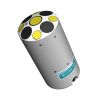SonTek RS5 Acoustic Doppler Current Profiler
Features
- SmartPulse+ utilizes Pulse-coherent and Broadband acoustic profiling that automatically adjusts based on conditions
- Vertical acoustic beam for the most accurate channel cross-sectional area in discharge applications
- Batteries and Bluetooth radio are housed in the RS5, eliminating external electric boxes
- Expedited repair and warranty service
- Lifetime technical support
- More
Overview
The HydroSurveyor is a system designed to collect bathymetric, water column velocity profile, and acoustic bottom tracking data as part of a hydrographic survey. The two key components of the system are the HydroSurveyor Acoustic Doppler Profiler (ADP) platform, and the powerful, yet user-friendly, data collection software. With the HydroSurveyor platform, SonTek is able to offer an exclusive 5-beam depth sounding device, with built-in navigation, full water column velocity (currents) profiling, full compensation for speed of sound (with the CastAway-CTD), and integrated positioning solution.
| Water Velocity Profiling | Profiling Range | 0.1-6 m (*1) |
| Velocity Range | ±5 m/s | |
| Accuracy | 1% ±0.002 m/s | |
| Resolution | 0.001 m/s | |
| Number of Cells | Up to 128 | |
| Cell Size | 2.5-30 cm | |
| Data Output Rate | 1.0 Hz | |
| Bottom Tracking | Depth Range | 0.1-6 m (*1) |
| Accuracy (*2) | 1% ± 0.002 m/s | |
| Resolution | 0.001 m/s | |
| Depth Measurement | Range | 0.1-6.5 m (*1) |
| Accuracy | 1% ±0.005 m | |
| Sensors | Temperature Sensors | Resolution: ±0.01°C Accuracy: ±0.5°C |
| Compass/Tilt Sensor | Range: ±180° Pitch/Roll, 0-360° Heading Heading Accuracy: ±2° Pitch/Roll Accuracy: ±1° |
|
| Transducers | Total Number | Five, 3.0 Mhz |
| Beam Angle | 25° | |
| Beam Width | 3° | |
| Bandwidth | 25% | |
| Battery Characteristics | Input Voltage | 3.3-4.2 VDC |
| Power Source - Li-Ion | 1x size 18650, Tenergy, Type 30016-04, 3.7Vdc, 2600mAh | |
| Battery Life - 1 x size 18650 | Seven hours continuous use, typical settings (*3) | |
| Power Consumption | 1.0 W (Average) | |
| Dimensions | 19.2 mm x 69.7 mm | |
| Communications | Radio Protocol | Bluetooth Low Energy (BLE5) |
| Range | 100 m (*4) | |
| Bluetooth Compliance | FCC Part 15, FCC ID: XPYNINAB30 ISED Certification: 8595A-NINAB30 |
|
| Environmental | Operation Temperature | -5° to 45°C (23°F to 113°F) |
| Storage Temperature | -20° to 70°C (-4°F to 158°F) | |
| Storage with Battery Temperature (*5) | -20° to 45°C (-4°F to 113°F) | |
| RS5 Physical Properties | Dimensions - HBII Micro | 76 cm (30”) x 50 cm (20”) x 11cm (4.25”) |
| Dimensions - RS5 Unit | 24 cm (9.5”) x 5 cm (2.2”) | |
| Weight in Air - RS5 Unit | 0.45 kg (1.0 lbs) | |
| Weight in Water - RS5 Unit | 0.15 kg (0.33 lbs) | |
| Weight in Air - RS5/HBII Micro/Geode | 3.63 kg (8.0 lbs) | |
| Waterproof Rating | IP67 | |
| DGNSS | Horizontal RMS | SBAS (WAAS): <0.3 m (0.98 ft) |
| 2DRMS | SBAS (WAAS): <0.6 m (1.96 ft) | |
| Frequency | L1, Multi-GNSS |
*Additional notes
1 Maximum range will vary with environmental conditions.
2 Bottom velocity accuracy.
3 Seven hours continuous use, typical settings.
4 When using provided SonTek USB radio with antenna.
5 Remove batteries from the RS5 if storage temperatures exceed the storage temperature of the Li-Ion battery.
- RS5 acoustic Doppler current profiler
- RSQ Windows software
- Plastic shipping case
- 3‐ft (91‐cm) radio antenna cable
- USB Bluetooth radio
- (2) Li‐Ion rechargeable batteries
- USB battery charger
In The News
Wildfire Prevention in the Sierra Nevada Region with the Yuba Watershed Institute
Though recent wildfires have sparked new conversations about wildfire management and response, groups like the Yuba Watershed Institute have been monitoring the forests and water resources of the Sierra Nevada region for decades, managing approximately 5,000 acres of land with the Bureau of Land Management (BLM) and about 7,000 acres in private land partnerships. The goal of the Institute is to work with local communities and land agencies to improve watershed and forestry management through informed practices and public outreach. The goals of the Yuba Watershed Institute are three-fold: Improve the ability of fire suppression agencies like the California Department of Forestry and Fire Protection ( CAL FIRE ) and the US Forest Service.
Read MoreWave Sensors Integration with NexSens Buoys: A Cutting-Edge Solution for Wave Measurment
Real-time wave data supports accurate weather prediction, safe and efficient maritime operations, and provides valuable safety and operating condition information for recreation and commercial fishing. Understanding wave dynamics also helps with the design of protective coastal structures like seawalls, breakwaters, and jetties. It also supports better prediction of their impact on sediment transport and coastal geomorphology. Wave data is a key factor in qualifying and designing offshore wind farms and harnessing kinetic energy for electrical generation. It helps with the understanding of ocean-atmosphere interactions and contributes to studies of sea-level rise and climate change impacts.
Read MoreSpring 2025 Environmental Monitor Available Now
In the Spring 2025 edition of the Environmental Monitor, we highlight partnerships across the world and the importance of collaboration between government agencies, universities, environmental groups, local communities, and other stakeholders. From great white shark research in Cape Cod to monitoring fisheries in Lake Erie, this latest edition underscores partnerships that connect stakeholders in a watershed through environmental data. With an emphasis on data sharing, a combination of real-time and discrete sampling keeps the public and partners informed of environmental conditions. Our writers also sought out science professionals dedicated to working with peers within and outside of the environmental sector.
Read More












